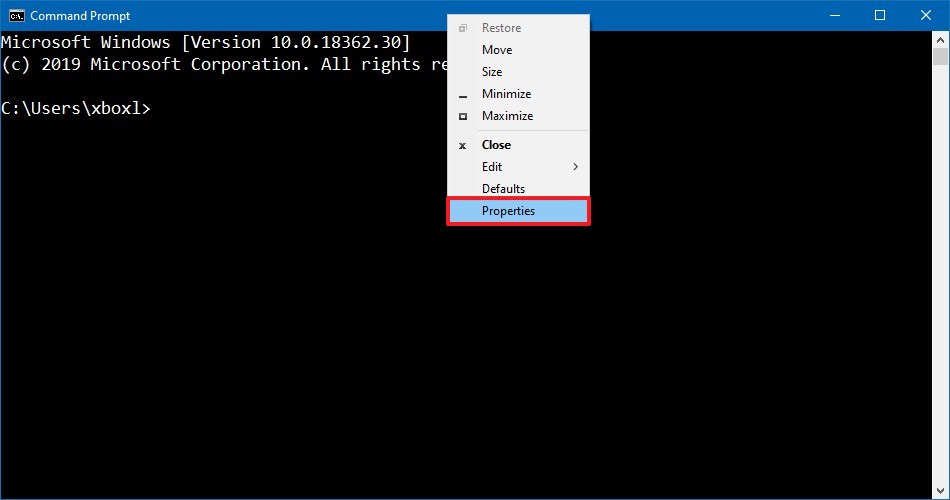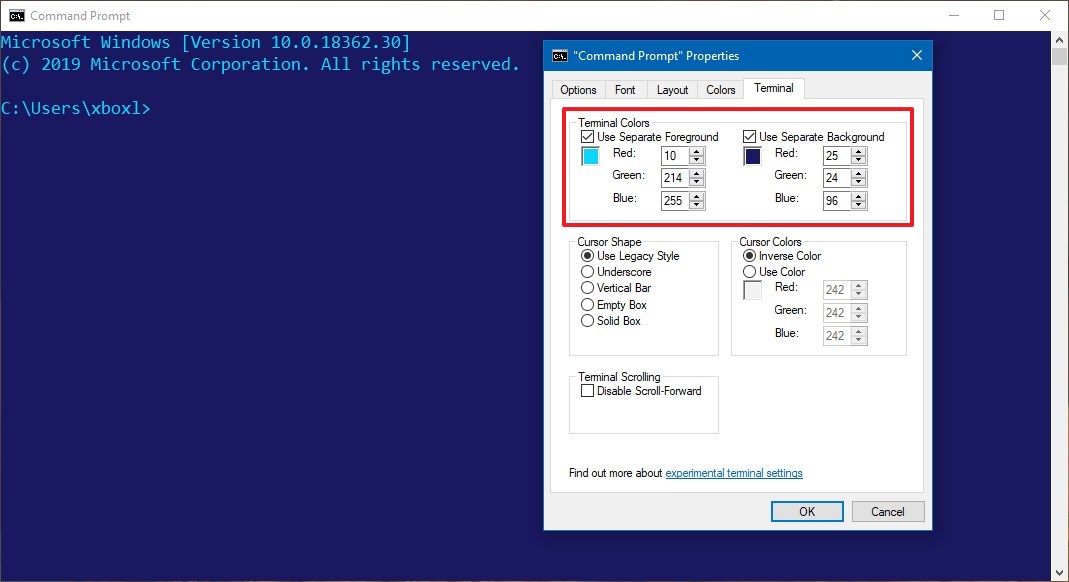How to customize Command Prompt using Terminal tab on the Windows 10 May 2019 Update
Command Prompt now includes a new Terminal tab to customize the experience further, and in this guide, we'll show you how to do it.

On Windows 10, in addition to the internal changes, Command Prompt has also been getting a lot of customization improvements, including the ability to use transparency, pick different cursor sizes, and change the appearance using a custom color scheme, and the efforts to improve the Windows Console continues with the first semi-annual update of 2019.
Starting with the May 2019 Update (version 1903), the Command Prompt properties window is getting a new "Terminal" tab with new settings to customize further the experience, including options to change the cursor shape, change the background and text colors, and more.

Windows 10 May 2019 Update full reviewHow to get the May 2019 Update ASAPMay 2019 Update common problems and how to fix themFull list of changes in the May 2019 UpdateAll of our May 2019 Update resources in one place
In this Windows 10 guide, we'll walk you through the steps to customize the Command Prompt experience using the new Terminal tab settings available with the May 2019 Update.
How to customize the Command Prompt look using terminal settings
To customize the look and feel of Command Prompt using the new "Terminal" settings, use these steps:
Important: Although you can still use the Colors tab to customize similar aspects of Command Prompt, these new Terminal settings will take precedence when changing the background and text colors.
- Open Start.
- Search for Command Prompt, right-click the top result, and select the Run as administrator option.
- Right-click the title bar and select the Properties option.

- Click the Terminal tab.
- Under the "Terminal Colors" section, check the Use Separate Foreground option to change the text color.
- Use the Red, Green, and Blue settings to select the RGB color for the screen text. Quick tip: The fastest way to find a new color is to search on Google for "RGB color picker." Then use the search engine built-in picker to select a color and find out its RGB value that you can use in the Terminal tab.
- Check the Use Separate Background option.
- Use the Red, Green, and Blue settings to select the RGB color for the screen background.

- Under the "Cursor Shape" section, you can select a different shape for the Command Prompt cursor:
- Use Legacy Style — enables the traditional thick underscore cursor.
- Underscore — allows a thinner cursor, but it's similar to the traditional option.
- Vertical Bar — enables a vertical cursor like the cursor you'll find in text editors.
- Empty Box — switches to an empty thick vertical cursor with border lines.
- Solid Box — switches to a solid thick vertical cursor without border lines.





- Under the "Cursor Colors" section, you can select between two color styles for the cursor.
- Inverse Color — inverts the color of the cursor based on the current background color.
- Use Color — allows you to specify a custom color for the cursor using RGB values.


- (Optional) Under the "Terminal Scrolling" section, you can check the Disable Scroll-Forward option to limit the scrolling up to the end of the last command input.

- Click the OK button.
Once you complete the steps, the new style changes will be available for Command Prompt whether you're using the console elevated or while in standard mode.
We're focusing this guide on Command Prompt, but these instructions will also work to customize the PowerShell and Linux consoles on Windows 10.
Get the Windows Central Newsletter
All the latest news, reviews, and guides for Windows and Xbox diehards.
Alongside the new customization settings, the May 2019 Update introduces a bunch of other changes for Command Prompt, PowerShell, and for the Windows Subsystem for Linux. You can find out more about these enhancements in this guide.
More Windows 10 resources
For more helpful articles, coverage, and answers to common questions about Windows 10, visit the following resources:
- Windows 10 on Windows Central – All you need to know
- Windows 10 help, tips, and tricks
- Windows 10 forums on Windows Central
Mauro Huculak has been a Windows How-To Expert contributor for WindowsCentral.com for nearly a decade and has over 15 years of experience writing comprehensive guides. He also has an IT background and has achieved different professional certifications from Microsoft, Cisco, VMware, and CompTIA. He has been recognized as a Microsoft MVP for many years.

